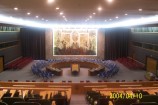 International Political Economy
International Political Economy
Monday 10:15 - 12:00 in OEC 1.162 and Tuesday 10:15 -12:00 in Theologicum TO.133
First lecture: January, 11th
Lecture number: 800908
Exercises: Wednesday 12:00-14:00 in ZHG 004 and 16:00-18:00 in Theo T01
Texts: Gene M. Grossman und Elhanan Helpman (2001) Special Interest Politics;
Dani Rodrik (1997) Has Globalization Gone Too Far?, Institute for International Economics;
Alberto Alesina und Enrico Spolaore (2003) The Size of Nations, MIT Press; selected papers.
Course material for participants is available at the course material webpage
Course Plan
0. Introduction
Theme I: Concepts and Tools of International Political Economy
1. Direct and Representative Democracy
Reference: Grossman and Helpman Ch. 2.1-2.3, 3.1.
2. Power Indices and Voting in International Organizations
Reference: A. Dixit and S. Skeath, 2004, Games of Strategy, 618-622.
Dennis Leech, 2002, Voting Power in the Governance of the International Monetary Fund, Annals of Operations Research 109, 375-397.
Annick Laruelle and Mika Widgren, 1998, Is the Allocation of Voting Power among EU States Fair?, Public Choice 94, 317-339.
3. EU Enlargement, EU Constitution, and Voting Right Reforms
Reference: R. Baldwin and M. Widgren, 2007, Pandora?s (Ballot) Box: Can the Constitution voting rules be improved? CEPR Policy Insight No. 4.
K. Zyczkowski et al., 2006, Physics for fairer voting, Physics World 19(3), 35-37.
4. Interest Groups: Rent-Seeking, Lobbying, and Campaign Contributions
Reference: D.C. Mueller, 2003, Public Choice III, Ch. 15 (333-337, 343-348, 355-357).
Grossman and Helpman Ch. 1.1.
5. Interest Groups: The Grossman-Helpman Model
Reference: Grossman and Helpman Ch. 7.1-7.3, 8.3.
6. Collective Action 1: Strategic Issues
Reference: Dixit and Skeath, 382-400, 359-361.
Mueller Ch. 2.1-2.3.
7. Collective Action 2: The Economics of Alliances
Reference: Dixit and Skeath, 387-400.
Mueller Ch. 2.4
Mancur Olson and Richard Zeckhauser, 1966, An Economic Theory of Alliances, Review of Economics and Statistics 48, 266, 279.
Theme II: Political Economy of International Trade
8. Models of International Trade: Ricardo-Viner and Heckscher-Ohlin
Reference: Krugman and Obstfeld: Ch. 3 and 4.
9. Trade Policy: Introduction
Reference: Krugman and Obstfeld: Ch. 5 and 8.
10. Custom Unions and Free Trade Areas
Reference: Krugman and Obstfeld: Ch. 9
Richard E. Baldwin et al., 1997, The Costs and Benefits of Eastern Enlargement:
The Impact on the EU and Central Europe, Economic Policy 12, 125-176.
11. Trade Wars and Trade Talks I
Reference: Krugman and Obstfeld: Ch. 9
Wolfgang Mayer, 1981, Theoretical Considerations on Negotiated Tariff Adjustments, Oxford Economic Papers 33, 135-148.
12. Endogenous Tariff Formation
Reference: Wolfgang Mayer, 1984, Endogenous Tariff Formation, American Economic Review 74, 970-985.
13. Protection for Sale
Reference: Elhanan Helpman, 1995, Politics and Trade Policy, NBER Working Paper 5309, pp 3-6, 10-13, 16-22.
Gene Grossman and Elhanan Helpman, 1994, Protection for Sale, American Economic Review, 84, 833-850.
14. Trade Wars and Trade Talks II
Reference: Gene Grossman and Elhanan Helpman,1995, Trade Wars and Trade Talks, Journal of Political Economy 103, 675.708.
Gene Grossman and Elhanan Helpman, 1995, The Politics of Free Trade Agreements, American Economic Review, 85, 667-690.
15. Globalization (Has it gone too far?)
Reference: Dani Rodrik, 1997, Has Globalization Gone Too Far?, Institute for International Economics.
Stanley Fisher, 2003, Globalization and its Challanges, American Economic Review 93(2). 1-30.
Michael D. Bordo et al., 1999, Is Globalization Today Really Different than Globalization a Hundred Years Ago?, NBER Working Paper 7195.
Theme III: The Number and Size of Nations
16. The Number and Size of Nations
Reference: Alberto Alesina und Enrico Spolaore (2003) The Size of Nations, MIT Press, Chapter 3 and 5.
17. The Breakup of Nations: A Political Economy Analysis
Reference: Patrick Bolton and Gerard Roland, The Breakup of Nations: A Political Economy Analysis, Quarterly Journal of Economics 112, 1057-1090.
18. Economic Integration and Political Disintegration
Reference: Alberto Alesina und Enrico Spolaore (2003), The Size of Nations, MIT Press, Chapter 6.
19. The Political Economy of International Unions (Has Europe gone to far?)
Reference: Alberto Alesina , Ignazio Angeloni and Federico Etro, 2005, International Unions, American Economic Review 95, 602-615.
Alberto Alesina and Romain Wacziarg, 1999, Is Europe going too far?, Carnegie Rochester Conference Series on Public Policy 51, 1-42.
Theme IV: Sovereign Debt
20. Sovereign Debt: Introduction and Conventional Theories
Reference: Maurice Obstfeld and Kenneth Rogoff, 1996, Foundations of International Macroeconomics, Chapter 6.1 and 6.2.
21. Sovereign Debt: New Developments
Reference: Panizza, U., Sturzenegger, F., and Zettelmeyer, J., 2009, The economics and law of sovereign debt and default; Journal of Economic Literature 47-47.
Gennaioli, N., Martin, A., and Rossi, S., 2012, Sovereign default, domestic banks, and financial institutions.
Tirole, J., 2012, Country Solidarity, Private Sector Involvement and the Contagion of Sovereign Crises.
22. European Debt Crisis -- Causes, Policies, and Political Economy Issues
References: H.-W. Sinn et al., 2012, The European Balance of Payments Problem. EEAG Report 2012, Chapter 2.
J. Tirole, 2012, The Euro Crisis: Some Reflections on Institutional Reform, Banque de France, Financial Stability Review 16.